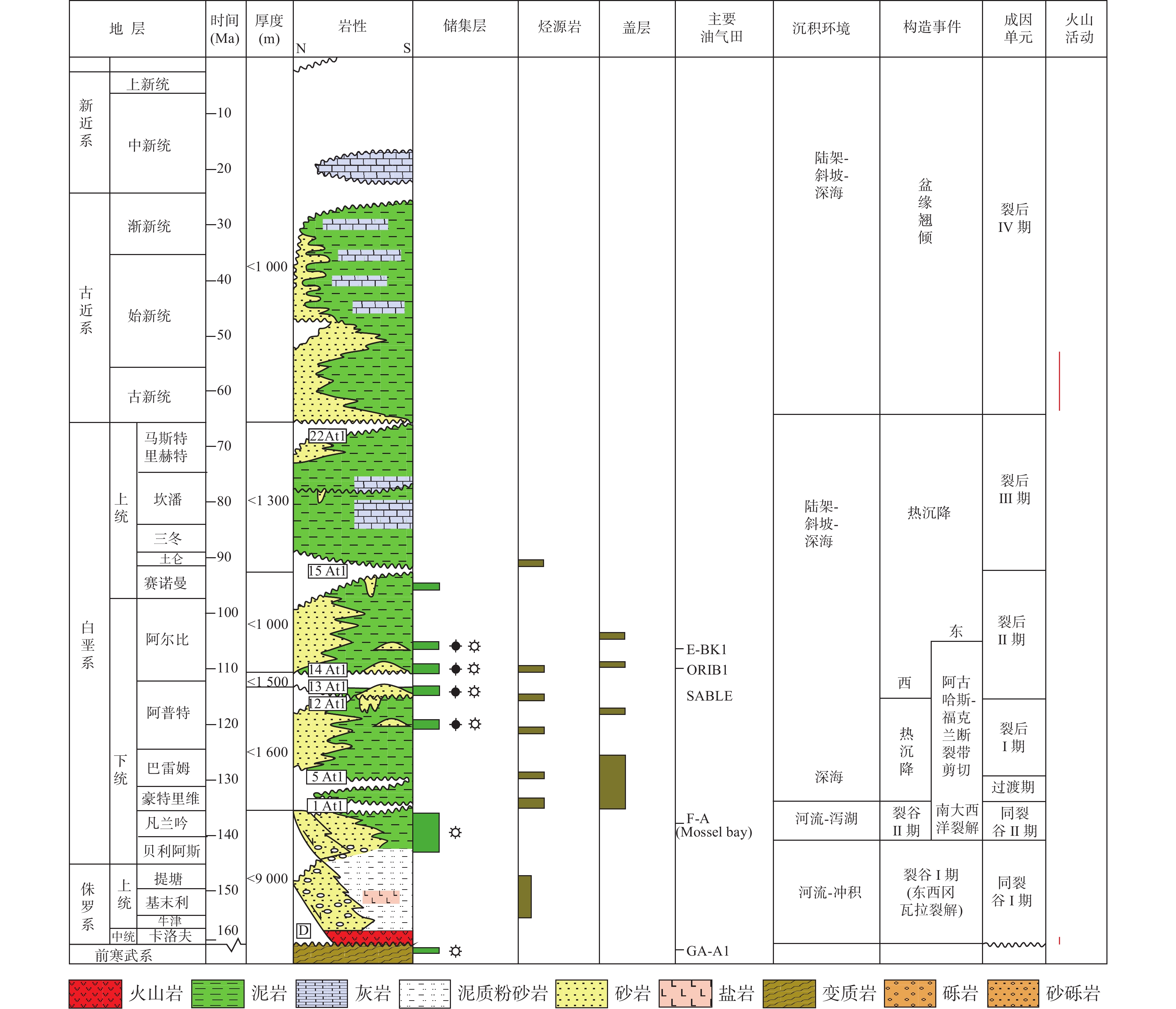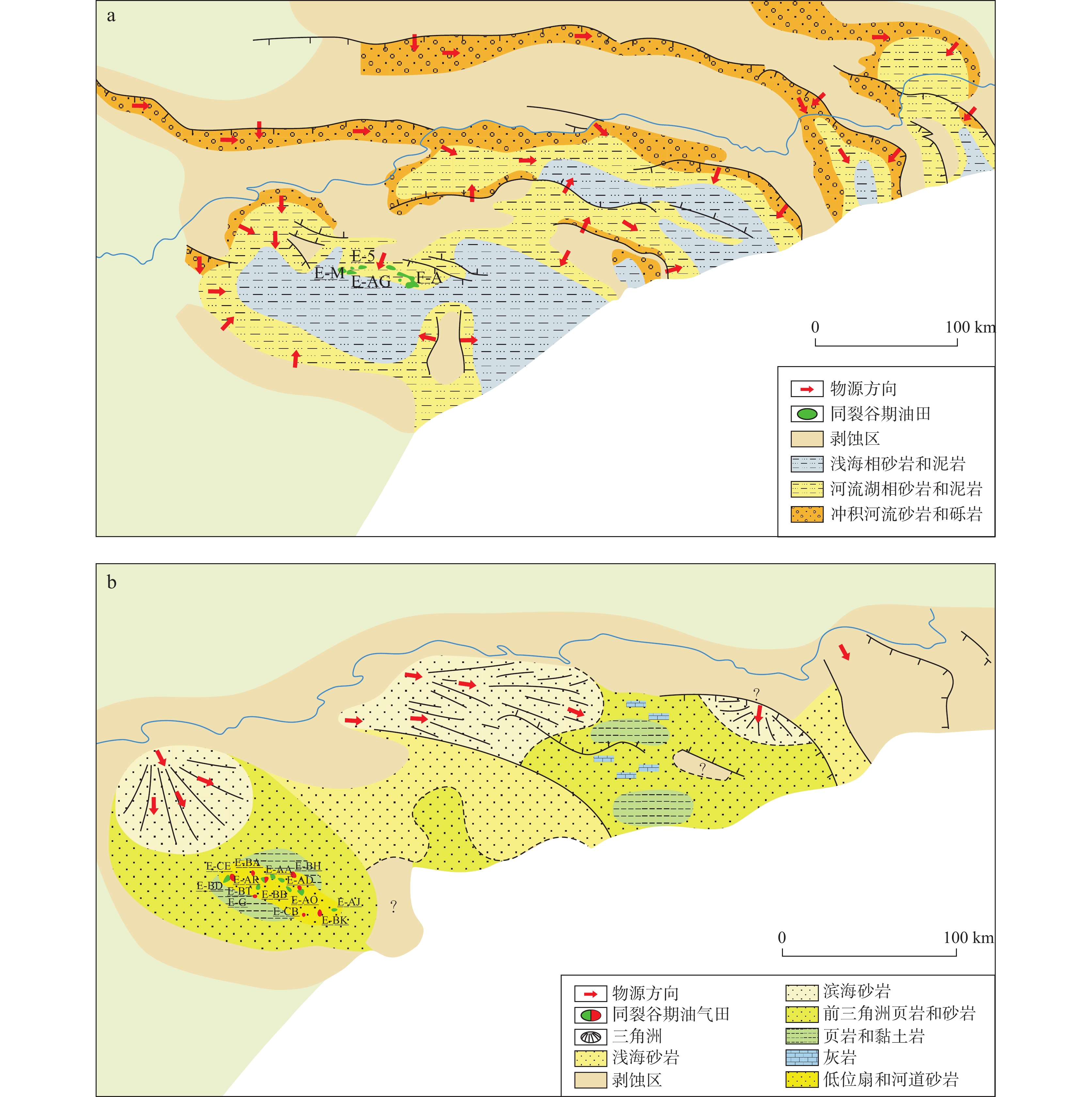Tectonic and Sedimentary Evolution and Hydrocarbon Accumulation in the Outeniqua Basin, South Africa
-
摘要:
南非奥特尼夸盆地油气勘探程度非常低,2019年与2020年连续的天然气大发现吸引了国内外油气公司广泛关注。基于IHS数据库、新项目评价及文献等资料,综合分析表明:奥特尼夸盆地经历了二叠纪以来的前裂谷、同裂谷、过渡期和裂谷后4个演化阶段;主要沉积了裂谷期陆相碎屑岩及过渡期–裂谷后的海相碎屑岩。盆地主力烃源岩为豪特里维阶和巴雷姆–阿普特阶海相页岩;发育了同裂谷期凡兰吟阶顶部浅海相砂岩和漂移早期阿尔比阶海相深水碎屑岩两套重要的储集层,储盖组合条件优越;共形成了巴雷姆–阿尔比阶砂岩、凡兰吟−豪特里维阶砂岩、上侏罗统−下白垩统砂岩和基底4套成藏组合。油气分布呈“西多东少”格局,目前应以Bredasdorp次盆大陆边缘深水区白垩系透镜状浊积砂岩为勘探重点。
Abstract:The degree of oil and gas exploration of Outeniqua Basin in South Africa is extremely low. The successive natural gas discoveries in 2019 and 2020 attracted extensive attention from oil and gas companies at home and abroad. Based on IHS database, assessment results of new ventures and literatures, comprehensive analysis shows that: The Outeniqua Basin experienced four evolutionary stages since the Permian period: pre-rift stage, syn-rift stage, transitional stage and post-rift stage; It mainly deposited continental clastic rocks in rift stage and marine clastic rocks in transitional stage and post-rift stage; The main source rocks in the basin are the marine shale of the Hauterivian period and Barremian-Aptian period; Two sets of important reservoirs, namely, the shallow marine sandstone at the top of the Valanginian in the syn-rift stage and the marine deep-water clastic rock of the Albian during the early drift period are developed, and the reservoir-seal combination conditions are superior; Four sets of reservoir-forming assemblages (plays) are formed, including Barremian-Albian sandstone, Valanginian-Hauterivian sandstone, Upper Jurassic-Lower Cretaceous sandstone and basement; The distribution of oil and gas is "more in the west and fewer in the east". At present, the exploration focus should be on Cretaceous lenticular turbidite sandstone in deep-water area of the continental margin of the Bredasdorp Sub-basin.
-
Key words:
- Outeniqua basin /
- South Africa /
- giant gas field /
- deep water /
- play /
- turbidite sandstone
-

-
图 3 奥特尼夸盆地不同构造位置剖面图(据IHS Energy,2021修)
Figure 3.
图 4 奥特尼夸盆地综合柱状图(据IHS Energy,2021修)
Figure 4.
图 5 奥特尼夸盆地重点时期岩相古地理图(据IHS Energy,2021修)
Figure 5.
图 6 奥特尼夸盆地不同时期Ro分布图(据IHS Energy,2021修)
Figure 6.
图 8 奥特尼夸盆地主要次盆成藏模式图(据文献Tellus, 2022修)
Figure 8.
表 1 奥特尼夸盆地烃源岩特征统计表
Table 1. Statistical table of source rock characteristics in Outeniqua basin
烃源岩地层 岩性 沉积相 干酪根 TOC(%) HI(mg /g) 上侏罗统 泥岩 湖相 I/II 1~4.3,平均2.5 平均300 豪特里维阶 页岩 深海 II/III 最大超4,平均2.8 400~500 巴雷姆-阿普特阶 页岩 深海 I/II 2.5~3.5,平均3 160~350,平均250 土仑阶 页岩 深海 I/II — — -
[1] 何拓平, 李元昊, 陈朝兵, 等. 深水重力流储层宏观非均质性控制因素-以华庆地区长63为例[J]. 西北地质, 2020, 53(1): 178-188
HE Tuoping, LI Yuanhao, CHEN Zhaobing et al. Macroscopic heterogeneity controlling factors of deepwater gravity flow reservoirs: a case study of Chang 63 in Huaqing area [J]. Northwestern Geology, 2020, 53(1): 178-188.
[2] 逄林安, 康洪全, 郝立华, 等. 南非奥坦尼瓜盆地构造演化与油气差异分布[J]. 海洋地质前沿, 2017, 33(3): 27-32
Pang Lin’an, Kang Hongquan, Hao Lihua, et al. Tectonic evolution and its bearing on Hydrocarbon different distribution in Outenique basin, South Africa [J]. Marine Geology Frontiers, 2017, 33(3): 27-32.
[3] 秦雁群, 张光亚, 梁英波, 等. 低勘探程度被动陆缘深水油气聚集研究方法: 以赤道大西洋波蒂瓜尔盆地深水油气远景勘探为例[J]. 地学前缘, 2014, 21(3): 187-194
Qin Yanqun, Zhang Guangya, Liang Yingbo, et al. Research methods of low-degree exploration in the deep water hydrocarbon accumulation of passive margin: case study on deep water oil and gas prospecting exploration of Potiguar Basin in the Equatorial Atlantic [J]. Earth Science Frontiers, 2014, 21(3): 187-194.
[4] 童晓光. 论成藏组合在勘探评价中的意义[J]. 西南石油大学学报(自然科学版), 2009, 31(6): 1-8
TONG Xiaoguang. A discussion on the role of accumulation association in the exploration evaluation [J]. Journal of Southwest petroleum university (Science & Technology Edition), 2009, 31(6): 1-8.
[5] 张光亚, 刘小兵, 温志新, 等. 东非被动大陆边缘构造-沉积特征及其对大气田富集的控制作用[J]. 中国石油勘探, 2015, 20(4): 71-80
Zhang Guangya, Liu Xiaobin, Wen Zhixin, et al. Structural and sedimentary characteristics of passive continental margin basins in East Africa and their effect on the formation of giant gas fields [J]. China Petroleum Exploration, 2015, 20(4): 71-80.
[6] 赵红岩, 梁建设, 孔令武, 等. 毛塞几比盆地油气成藏条件特征分析[J]. 西北地质, 2021, 54(1): 179-184
ZHAO Hongyan, LIANG Jianshe, KONG Lingwu, et al. Hydrocarbon accumulation characteristics in Maosai Kibi basin [J]. Northwestern Geology, 2021, 54(1): 179-184.
[7] 中国石油勘探开发研究院. 全球油气勘探开发形势及油公司动态(2020年)[M]. 北京: 石油工业出版社, 2020
RIPED. Global petroleum E&D trends and company dynamics (2021) [M]. Beijing: Petroleum Industry Press, 2020.
[8] 中国石油勘探开发研究院. 全球油气勘探开发形势及油公司动态(2021年)[M]. 北京: 石油工业出版社, 2021
RIPED. Global petroleum E&D trends and company dynamics (2021) [M]. Beijing: Petroleum Industry Press, 2021.
[9] Akinlua A, Sigedle A, Buthelezi T, et al. Trace element geochemistry of crude oils and condensates from South African Basins [J]. Marine and Petroleum Geology, 2015, 59: 286-293. doi: 10.1016/j.marpetgeo.2014.07.023
[10] Ayodele O, Donker J, Opuwari M. Pore pressure prediction of some selected wells from the Southern Pletmos Basin, offshore South Africa [J]. South African Journal of Geology, 2016, 119 (1): 203-214. doi: 10.2113/gssajg.119.1.203
[11] Davies C. Hydrocarbon evolution of the bredasdorp basin, offshore South Africa: from source to reservoir [D]. Western Cape: University of Stellenbosch, 1997.
[12] Harris P, Whiteway T. Global distribution of large submarine canyons: geomorphic differences between active and passive continental margins [J]. Marine Geology, 2011, 285(1-4): 69-86. doi: 10.1016/j.margeo.2011.05.008
[13] Hiller K, Shoko U. Hydrocarbon source rock potential of the Karoo in Zimbabwe [J]. Journal of African Earth Sciences, 1996, 23(1): 31-43. doi: 10.1016/S0899-5362(96)00050-4
[14] IHS Energy. EDIN [EB/OL]. http://www.ihsenergy.com. (2020-12-20) [2021-02-15].
[15] Lawrence A. A review of producing fields inferred to have upslope stratigraphically trapped turbidite reservoirs: Trapping styles (pure and combined), pinch-out formation, and depositional setting [J]. AAPG Bulletin, 2019, 103 (12): 2861–2889. doi: 10.1306/02251917408
[16] Ojongokpoko H. Porosity and permeability distribution in the deep marine play of the central bredasdorp basin, block 9, offshore South Africa [D]. Western Cape: University of the Western Cape, 2006.
[17] Opuwari M, Dominick N. Sandstone reservoir zonation of the north-western Bredasdorp Basin South Africa using core data [J]. Journal of Applied Geophysics, 2021, 193: 104425-104430. doi: 10.1016/j.jappgeo.2021.104425
[18] Roux J. The structural development of the Southern Outeniqua Basin (SOB) and Dias Marginal Fracture Ridge (DMFR) [J]. Africa Geoscience Review, 2001, 8 (1-2): 209.
[19] Singh V, Brink G, Winter H, et al. New interpretation reveals potential in onshore Algoa basin, South Africa [J]. Oil and Gas Journal, 2005, 103(1): 34-39.
[20] Tellus. Tellus data [EB/OL]. http://www.fugro-robertson.com/products/tellusFRL. (2021-6-30) [2022-04-15].
[21] Van D. Source rocks and modelled maturity levels in the southern Outeniqua Basin, offshore South Africa [J]. Africa Geoscience Review, 2001, 8 (1-2): 141-147.
[22] Van Der S. Aptian source rocks in some South African, Cretaceous basins[C]//Arthur T, Macgregor D, Cameron N. Petroleum geology of Africa: New themes and developing technologies. London: The Geological Society of London, 2003, 207: 185-202.
[23] Winters S, Brink G, Kuhlmann S. Integration of reservoir and source rock distribution with seismic-sequence stratigraphy and geophysical modelling in the discovery of hydrocarbons within a Cretaceous sequence, Bredasdorp Basin, South Africa [J]. AAPG Bulletin, 1992, 76(13): 143.
-




 下载:
下载:






